In his latest article for the ATM (25.2) journal, SPORTENG Senior Turfgrass Agronomist John Neylan reflects on some recent projects and facility inspections and the management issues arising, which reinforce the need for turf managers to be ever-vigilant.
Over the past few months, there have been a few situations presented themselves which are worth reviewing and discussing. Whether it’s issues relating to drainage, the increasing cost or lack of certain resources or the ongoing need to be continually observant and reassessing turf management programs, sports turf managers are always learning and needing to adapt in their quest to produce the best surfaces possible.
Among John's recent travels, a few things in particular have caught his attention. Drainage is one such topic that is never far away from his mind, and it is one of the most critical components to successfully maintaining high-quality turf surfaces. This has never been more important with recent high rainfall events and floods, with a couple of examples highlighting the importance of ongoing drain maintenance to ensure they continue to perform adequately.
Elsewhere, unrest around the world has impacted the availability of many resources used in turf maintenance, with fertilisers and their cost high on the list. At the same time, there has been a rapid expansion in sports fields and sports field usage but also a squeeze on budgets. Planning and making sure that all operations are cost-effective has never been more important.
On the topic of resource availability, the lack of coir fibre and peat moss has created issues where amendments are required to increase the water-holding capacity of sands for sports turf construction projects. Compost has been suggested as an alternative which increases the importance of understanding what compost is, what the Australian Standard is, what the appropriate testing is and how it could be incorporated into a turf profile.
And finally, the topic of sand quality for construction projects and topdressing has been raised yet again in terms of meeting specifications and the importance of testing before use. Let’s take a look at each of the abovementioned topics in a little more detail…
Drainage maintenance: a lifelong commitment
Over the past two years, the effects of La Niña have resulted in unprecedented rainfall and created many challenges for turf managers in preparing acceptable playing surfaces, let alone having to deal with flooding. After inspecting some golf course fairways and flooded sports fields in recent months, one aspect that has become apparent is the damage to the subsoil drainage system.
In heavy clay soils, subsoil drains are often installed as sand-backfilled drains where the removal of water is dependent on the sand backfill capturing surface water. When this backfill is capped by soil and organic matter, the efficiency of the drains drops dramatically.
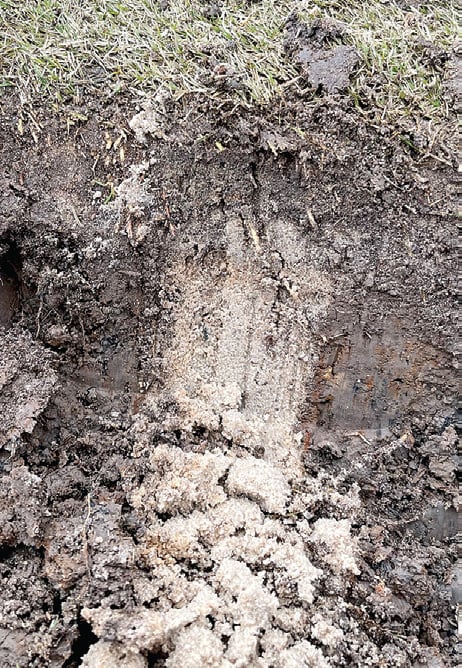
Soil and organic matter capping a sand-backfilled drainage line on a sports field.
The flooding of sports fields and golf course fairways provides the additional challenge where silt deposits will cap and seal the drains, and any remedial works undertaken need to remove the silt back to the sand backfill. Inspecting different sites over the past few months where the sand-backfilled drains were either capped with soil and organic matter or were being upgraded, it was interesting to see the methodology being implemented.
On a sports field that had been flooded, the vegetation and most of the silt had been stripped using a Koro Field Topmaker (FTM).
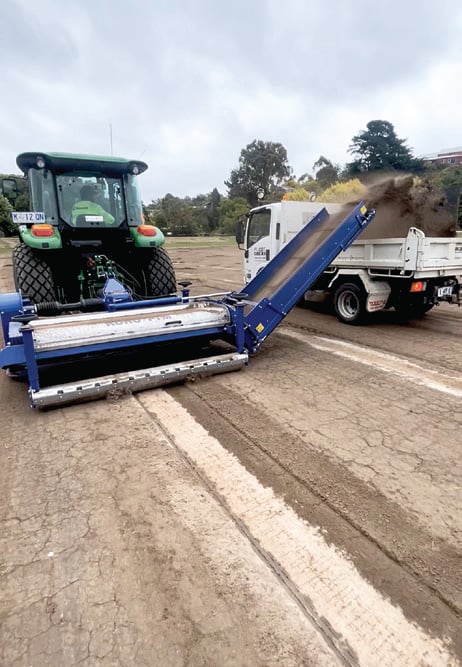 A modified Koro Field Topmaker striping silt layers capping drain lines, exposing the sand layer beneath.
A modified Koro Field Topmaker striping silt layers capping drain lines, exposing the sand layer beneath.
What was apparent was the thin layer of silt still remaining that was capping the sand-backfilled drains. In this instance, the FTM was modified (the number of teeth was reduced) so that the silt layer could be stripped, exposing the sand layer beneath. This allowed for additional sand to be imported and linked in with the sand backfill, ensuring the effective functioning of the existing subsoil drains and adequate surface drainage.
At Killara Golf Club in Sydney, where sand slit drains have been installed due to the site’s fine-textured soils, there is now a program of regular sand grooving/slitting to link in with the existing drains (see photo below).
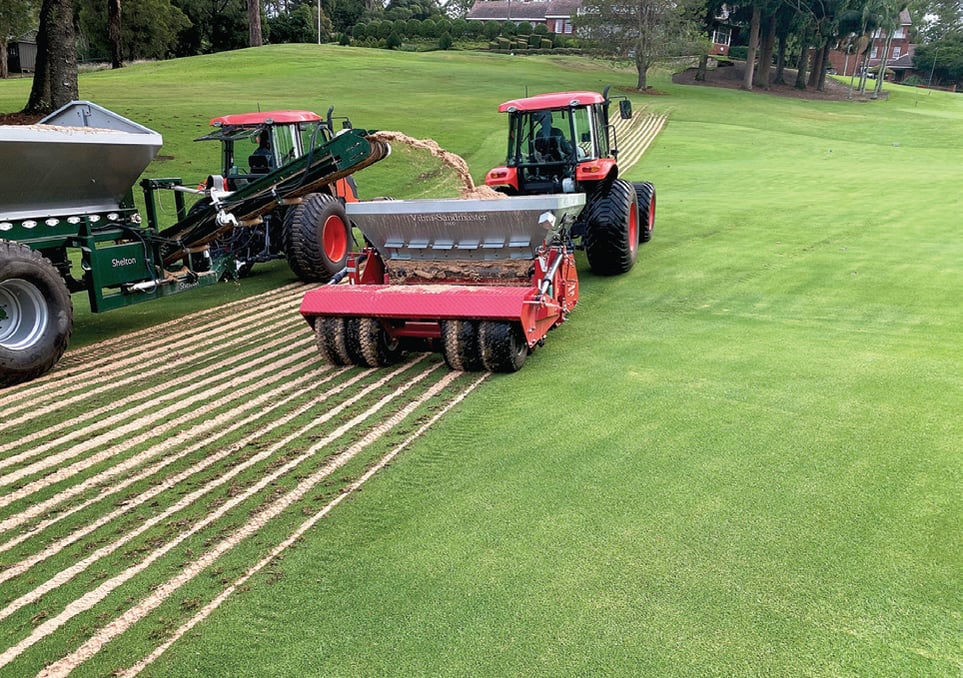 Killara Golf Club in Sydney now has a regular program of sand grooving/slitting to link with the existing drains.
Killara Golf Club in Sydney now has a regular program of sand grooving/slitting to link with the existing drains.
The close spacing of the sand grooves allows for more efficient intercepting of water as well as maintaining the function of the existing drains. The machine used in this instance was a Vibra- Sandmaster from Redexim, which de-compacts and adds surface drainage to the soil profile in a single pass. Integrated within the Vibra-Sandmaster is the Verti-Quake 2516, which de-compacts and opens the soil to a depth of 250mm. Vibrating coulters fill the slits with sand to leave minimal surface disruption. In this situation, the turf is Kikuyu, and recovery took about 3-4 weeks with minimal disruption to golf.
TAKE HOME MESSAGE
Sub-soil drainage needs ongoing maintenance, forever!
Evaluate the cost-effectiveness of turf maintenance operations
At a time when budgets are tight, it is important to evaluate the cost-effectiveness of every operation involved in maintaining turf areas. It is notable that within local government, there has been a rapid expansion of sports turf areas in response to increasing populations and the demand for playing surfaces.
Interestingly, the common complaint is that while the number of hectares of sports turf is increasing, the budgets for maintenance have remained relatively stagnant. Consequently, there has been a call out for sports field profiles to be designed that require fewer inputs, such as water and fertiliser. This is all well and good, but this neglects what is going to provide a well-drained winter profile when wear is going to be greatest.
Rising global energy prices have caused substantial increases in fertiliser prices. Between January 2021 and December 2022, the average Free on Board (FOB) price of Australian fertiliser imports rose by 128 per cent, from $380/tonne to $867/tonne. The basis of many blended fertilisers, urea increased from $256/tonne to $1026/tonne.
(Source: www.austrade.gov.au).
The war in Ukraine has also impacted the availability of fertilisers and contributed to rising costs. There has been an adjustment at the start of 2023 with the FOB price of urea from Black Sea ports around $769/tonne, which is down 38 per cent on highs seen last year. While this is good news, prices are still almost double the five-year average before 2022 (Source: www.ruralbank.com.au).
If we consider fertiliser a significant input next to the use of fuel for mowing and other maintenance activities, it reinforces the need to re-evaluate what is an appropriate fertiliser program and the associated costs. In articles by Zontek et. al. (2010) and Meentemeyer and
Whitlark (2016), both make several pertinent points around the cost of fertiliser, including:
- Fertiliser comes in many different formulations, blends and price ranges, but does the grass know the cost? The answer is ‘No’.
- All nutrients enter grass plants in an inorganic form. It is important to remember that nitrogen controls turfgrass growth more than any other macronutrient.
- When purchasing nitrogen fertiliser, it is important to calculate the cost per kilogram or cost per hectare of actual nitrogen. This is a fundamental management activity.
The old-fashioned ‘cause and effect’ needs to be taken into consideration, and when formulating and reviewing a fertiliser program, the following questions need to be asked:- What is the annual target rate for N and K/year?
- What was applied?
- What was the form of fertiliser?
- How much N was applied per hectare?
- What was the response of the turf?
- How well did the surface perform across the winter months?
- What was the cost?
Undertaking this evaluation is a key role of the turf manager so as to deliver good quality, cost-effective playing surfaces that are safe and fit for purpose.
TAKE HOME MESSAGE
At a time when there are many cost pressures in delivering suitable turf playing surfaces, all inputs need to be assessed and determined whether they are delivering the required outcomes that are cost-effective.
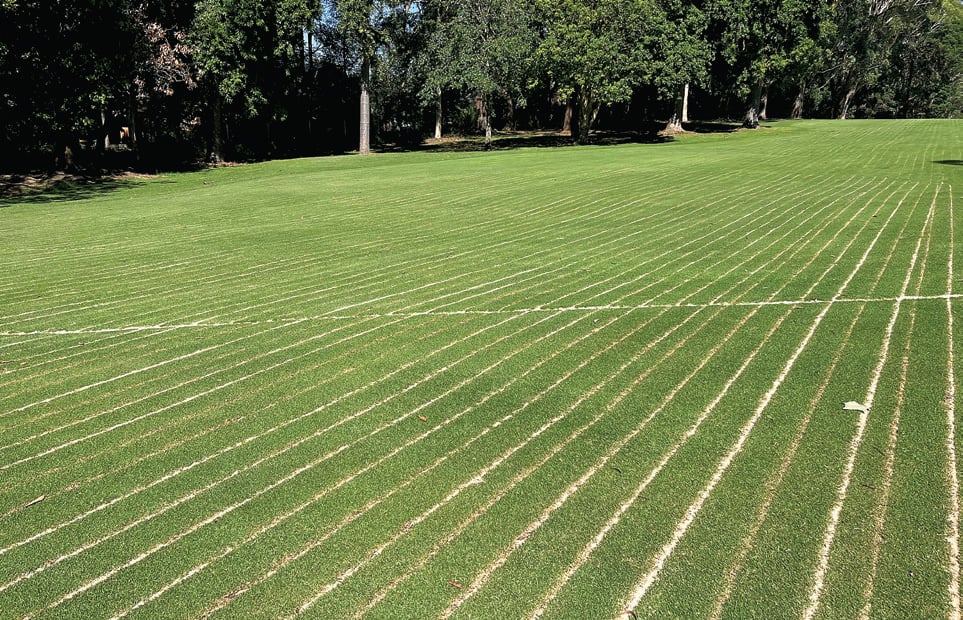
The close spacing of the sand grooves allows for more efficient intercepting of water as well as maintaining the function of the existing drains.
Compost: an alternative to coir fibre and peat moss.
Many sands used to construct golf greens and sports fields have low capillary porosity (moisture retention) and need the addition of an organic amendment to ensure it is within the optimum range (i.e., 15-25 per cent by volume at 30cm tension). The two main organic amendments typically used are coir fibre and peat moss, which have an organic matter content of at least 85 per cent by weight (USGA, 2018).
With several construction projects over the past 18-24 months, there has been a reported shortage of coir fibre and peat moss, which has led to a search for a viable alternative.
Compost has been proposed, which has received mixed responses from contractors. The main concern is the inconsistency of the compost and, in particular, the presence of large particles and non-composted plant material such as twigs and bark.
From an agronomic perspective, the question needs to be whether there are accepted criteria for compost and an understanding of how it can be used in a sand profile. The USGA Recommendations for a Method of Putting Green Construction (2018 Revision) has been a guiding light for the methodology and quality control aspects of building sand-based profiles. Fortunately, they have considered the use of compost as an alternative form of organic matter. Citing the information on the addition of organic matter from the USGA guidelines, they state the following for peats and composts…
- Peats: the most common organic amendment used in rootzone mixtures is peat. The most common types of peat are sphagnum moss peat and reed sedge peat. They must have an organic matter content of at least 85 per cent by weight as determined by loss on ignition (ASTM D2974, Method C). The peat shall be screened to no larger than 6.4 mm.
- Composts: compost may be considered as an organic amendment if the product is composted through the thermophilic stage to the mesophilic maturation stage. The compost should be aged for one year to ensure it is fully mature. In addition, a rootzone mixture amended with compost must meet the physical performance parameters outlined in the guidelines. The guidelines also highlight that the common problem with composts is that they can vary by source and from batch to batch within a source. Extreme caution must be exercised when using compost in rootzone mixtures and must meet the following parameters:
- 95-100 per cent passing a 6.4mm sieve;
- Organic matter content ≥ 50 per cent as determined by ASTM D2974, Method C;
- Carbon-nitrogen ratio between 15:1-30:1;
- Solvita Compost Maturity Index of 7-8 (https://solvita.com/compost/);
- Electrical conductivity ≤ 6dS/m;
- pH between 4-8;
- Proven to be non-phytotoxic;
- Meet or exceed ceiling concentrations and pollutant concentrations as specified by US EPA Class A standard.
- Any test report on compost must be less than one month old and represent the actual compost that will be used to amend the rootzone mixture.
There is an Australian Standard that details the criteria for composts, soil conditioners and mulches (AS 4454-2012 AMD 2:2018). The Standard specifies the requirements for organic products that are to be used to amend the physical and chemical properties of natural or artificial soils and growing media. The Standard is very comprehensive and applies to organic products and mixtures of organic products that have been treated by pasteurising or composting procedures as defined by the Standard. The objective of the Standard is to provide the minimum requirements for the physical, chemical and biological properties of composts, soil conditioners, mulches and vermicast. The purpose is to minimise the adverse impacts on the environment and public health.
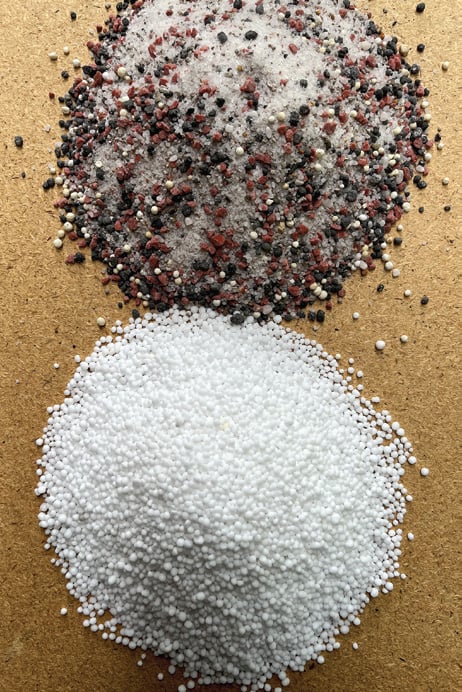
With the price of fertiliser increasing, it reinforces the need for turf managers to re-evaluate what is an appropriate fertiliser program and its costs.
Compost is defined as an organic product that has undergone controlled aerobic and thermophilic biological transformation through the composting process to achieve pasteurisation and reduce phytotoxic compounds and achieve a specified level of maturity required for compost. Composts that have gone through these processes become mature and stable over time.
The term ‘stable’ typically refers to a compost that has stopped undergoing rapid decomposition and whose nutrients are slowly released into the soil. Stability is important in determining the potential impact of the compost material on nitrogen availability in soil or growth media. Stable compost consumes little nitrogen and oxygen and generates little carbon dioxide or heat. Unstable, active compost demands nitrogen when applied to soil and growth media. Composts that cause nitrogen deficiency can be detrimental to plant growth, even causing death to plants in some cases. If stored improperly and left unaerated, unstable compost can become anaerobic and generate nuisance odours.
Maturity is the level of completeness of the composting process. Therefore, mature compost is important because it will not adversely affect plant development due to reduced oxygen or nitrogen availability and/or the presence of phytotoxic compounds.
It takes time, and the appropriate aeration techniques for organic material to be properly composted can take many months.
The Standard is comprehensive and details all of the tests to ensure that the compost complies with the requirements of maturity and doesn’t contain any phytotoxic compounds or weed propagules. In reviewing a recent test of compost, there were 55 factors analysed, including physical characteristics, chemistry characteristics (including pH, EC, nutrients, cations, anions and heavy metals), pesticides, pathogens, contaminants (e.g., glass, plastic etc.), plant growth test and viable plant propagules.
It is important to note that the Standard requires compost to have total organic carbon levels of 20 per cent, which equates to about 34 per cent organic matter. This is less than the USGA recommendation of 50 per cent.
The other key is that the Standard specifies no more than 20 per cent by mass in the shortest dimension to be retained by the 16mm sieve, whereas the USGA recommends <5 per cent retained on the 6mm sieve. Particle size has been a negative aspect of some composts used in modifying sports field profiles.
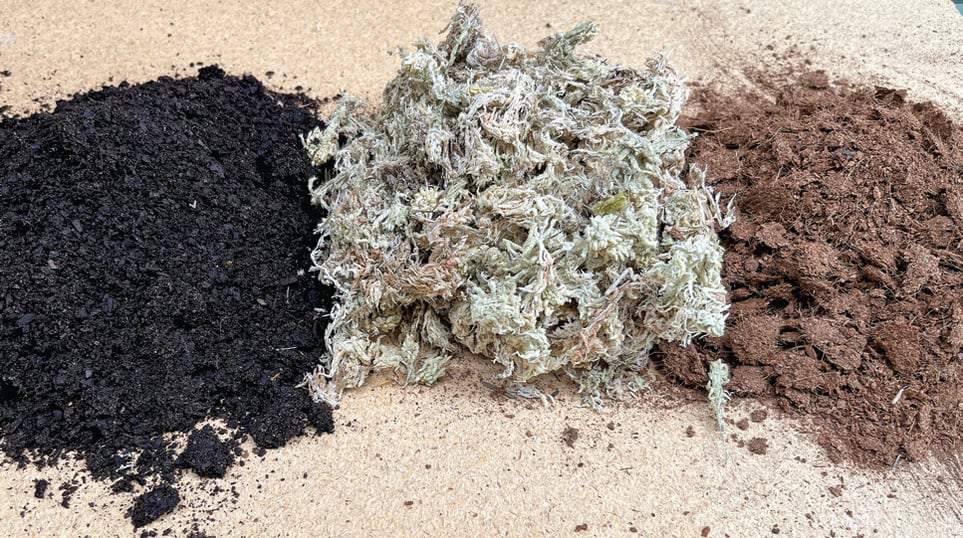
Samples (from left) of compost, sphagnum peat moss and coir fibre. A shortage of the latter two has led to compost being proposed more as an alternative organic amendment in sports turf profiles.
So, can we use compost as an alternative to coir fibre and peat moss? The short answer is yes; however, detailed testing and adherence to the Australian Standard (AS 4454-2012) are essential. The guidelines must also be used for the turf rootzone-specific application. The critical criteria that must be adhered to are as follows:
- Meets all of the test standards detailed in the Australian Standard;
- Organic matter content is >50 per cent;
- The particle size is less than 16mm;
- The compost is mature and proven so;
- The testing reflects the compost to be used in the project;
- Undertake laboratory testing by blending the compost with the selected sand at a minimum of five and 10 per cent by volume and testing capillary porosity, aeration porosity and compacted hydraulic conductivity.
TAKE HOME MESSAGE
The way of the world constantly dictates that we must be adaptable. While this is the case, it doesn’t mean that we don’t undertake the appropriate testing so that we have the best technical information available before we make a final decision.
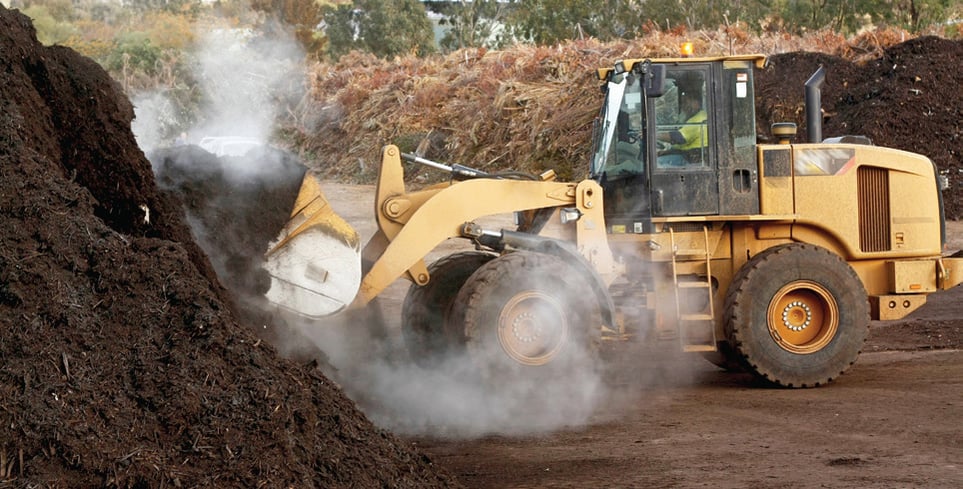
Compost can be used as an alternative to coir fibre and peat moss; however, detailed testing and adherence to the Australian Standard is essential.
Sourcing suitable sands, a true challenge for the turf industry
The turf industry has very specific requirements for sand rootzones; however, the availability of suitable and consistent sands has become more challenging as the construction industry consumes most of this important resource for asphalt and concrete. This increasing demand has resulted in increased costs for the sand, and added to this cost, there has been an increase in the cost of transport.
As a consequence, there has been an ongoing search for sands and gravels to supply the turf industry. There has been some very unsatisfactory material submitted as an alternative, and unfortunately, in some situations, this material has been used.
On two separate projects in NSW and Victoria, topdressing was undertaken where the sand was contaminated with rocks and building rubble. Several missteps were involved – the lack of sand testing prior to delivery, the absence of contractor care and the lack of attention by the operator to what was taking place. Once it was on the ground, there was a lot of work to clean it up, including manual collection, sweeping, dethatching and vacuuming on multiple occasions.
 Rocks and building rubble contained in some of the badly contaminated topdressing sand.
Rocks and building rubble contained in some of the badly contaminated topdressing sand.
Fortunately, these mishaps are in the minority; however, as cost pressures increase and the engineers and managers go through their value management process (i.e., cost cutting), there will always be a temptation to go for cheaper inputs.
Sand is potentially the single greatest cost in a construction project and accounts for about 20-25 per cent of the total cost. Over the past five years, the cost of sports field construction has increased by about 20 per cent across the entirety of the project (SPORTENG, 2022), with sand being a significant component.
It becomes important that project managers closely follow the specifications to ensure that a predictable outcome is achieved. This includes making sure that the sands are stockpiled, tested and then, when approved and delivered to site are visually inspected to look for excessive large particles, rubble and other rubbish such as glass.
TAKE HOME MESSAGE
Specify, test, check and test again!
Interested in learning more about optimising your turf project? Contact our Field of Play Team today to discuss your specific project needs and discover tailored solutions for success. Get in touch now to start transforming your turf management strategies!
Return to the main blog page.

